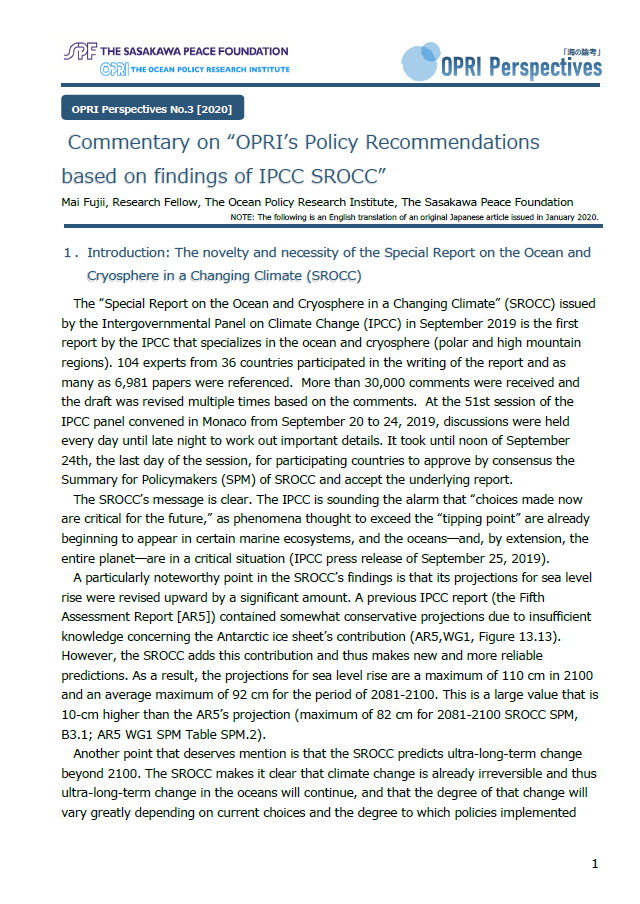Publications
Commentary on “OPRI’s Policy Recommendations based on findings of IPCC SROCC”
Please click here for the PDF file download
【Introduction】
The “Special Report on the Ocean and Cryosphere in a Changing Climate” (SROCC) issued by the Intergovernmental Panel on Climate Change (IPCC) in September 2019 is the first report by the IPCC that specializes in the ocean and cryosphere (polar and high mountain regions). 104 experts from 36 countries participated in the writing of the report and as many as 6,981 papers were referenced. More than 30,000 comments were received and the draft was revised multiple times based on the comments. At the 51st session of the IPCC panel convened in Monaco from September 20 to 24, 2019, discussions were held every day until late night to work out important details. It took until noon of September 24th, the last day of the session, for participating countries to approve by consensus the Summary for Policymakers (SPM) of SROCC and accept the underlying report.
The SROCC’s message is clear. The IPCC is sounding the alarm that “choices made now are critical for the future,” as phenomena thought to exceed the “tipping point” are already beginning to appear in certain marine ecosystems, and the oceans―and, by extension, the entire planet―are in a critical situation (IPCC press release of September 25, 2019).
A particularly noteworthy point in the SROCC’s findings is that its projections for sea level rise were revised upward by a significant amount. A previous IPCC report (the Fifth Assessment Report [AR5]) contained somewhat conservative projections due to insufficient knowledge concerning the Antarctic ice sheet’s contribution (AR5,WG1, Figure 13.13). However, the SROCC adds this contribution and thus makes new and more reliable predictions. As a result, the projections for sea level rise are a maximum of 110 cm in 2100 and an average maximum of 92 cm for the period of 2081-2100. This is a large value that is 10-cm higher than the AR5’s projection (maximum of 82 cm for 2081-2100 SROCC SPM,B3.1; AR5 WG1 SPM Table SPM.2).
Another point that deserves mention is that the SROCC predicts ultra-long-term change beyond 2100. The SROCC makes it clear that climate change is already irreversible and thus ultra-long-term change in the oceans will continue, and that the degree of that change will vary greatly depending on current choices and the degree to which policies implemented going forward are realized (See Figure 1 on the following page). A comparison of a scenario in which high greenhouse gas (GHG) emissions continue (RCP 8.5) and a low-emissions scenario in which GHG emissions are greatly reduced (RCP 2.6) reveals that significant differences emerge with the passage of time for all items. However, for sea level, in particular, it is predicted that sea levels will continue to rise even after the year 2300 in the high-emissions scenario. We undoubtedly stand at a crossroads at which the “choices made now are critical for the future.” Given this, we must lead efforts to mitigate global climate change (reduce GHG emissions), focusing on the oceans and mobilizing the entire nation to respond appropriately to changes in ocean environments so that we may ensure sustainable development into the future. It was with this in mind that, in October 2019, the Ocean Policy Research Institute of the Sasakawa Peace Foundation announced the following ocean related policy recomendations. This discussion will examine each of the recommendations through concrete examples, and present the reports and papers upon which they are based.
